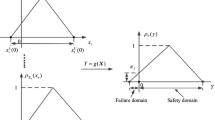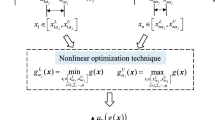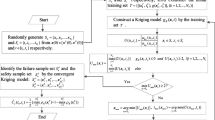Abstract
The system failure possibility of multi-mode structural system (referred to as system) under fuzzy uncertainty is the joint membership function of input vector at the system fuzzy design point, and it can reasonably measure the safety degree of the system. The system fuzzy simulation (S-FS) can be combined with adaptive Kriging model (AK-S-FS) to solve the system failure possibility. In the current AK-S-FS method, the system fuzzy design point is searched in the maximum value region of the fuzzy input vector corresponding to the 0 membership level, and its computational efficiency still needs to be improved. Thus, a hierarchical system fuzzy simulation combined with adaptive Kriging model (AK-HS-FS) method is proposed to improve the efficiency of searching the system fuzzy design point in this paper. The efficiency of the proposed AK-HS-FS method comes from the innovative strategies of three aspects. The first is the strategy of the hierarchical system fuzzy simulation (HS-FS). Compared with the S-FS with the system fuzzy design point searched roughly in the maximum possible value region, the strategy of the HS-FS is to exploratively expand the search region by transferring from a larger membership level to a smaller one. The overall search region of the system fuzzy design point can be reduced without losing the search accuracy in the HS-FS. The second is the strategy of the hierarchical training. Compared with training the system Kriging model in the combined candidate sample pool (CSP) of all layers, it is more time-saving to train the system Kriging model layer by layer in the hierarchical CSP. The third is the strategy of iteratively reducing the CSP. According to the properties of the system fuzzy design point and the probability properties of the Kriging prediction, the required time of training the system Kriging model can be further reduced by iteratively reducing the CSP, and the reduction of the CSP can ensure the accuracy without introducing any computational cost and complexity. The results of case studies fully verify that the AK-HS-FS is much more efficient than the AK-S-FS under satisfying the computational accuracy.
















Similar content being viewed by others
References
Bichon BJ, Mcfarland JM, Mahadevan S (2011) Efficient surrogate models for reliability analysis of systems with multiple failure modes. Reliab Eng Syst Saf 96(10):1386–1395
Bourinet JM (2016) Rare-event probability estimation with adaptive support vector regression surrogates. Reliab Eng Syst Saf 150:210–221
Cheng K, Lu ZZ, Zhou YC, Shi Y, Wei Y (2017) Global sensitivity analysis using Support Vector Regression. Appl Math Model 49:587–598
Cremona C, Gao Y (1997) The possibilistic reliability theory: theoretical aspects and applications. Struct Saf 19(2):173–201
Echard B, Gayton N, Lemaire M (2011) AK-MCS: an active learning reliability method combining Kriging and Monte Carlo simulation. Struct Saf 33(2):145–154
Elhewy AH, Mesbahi E, Pu Y (2006) Reliability analysis of structures using neural network method. Probabil Eng Mech 21(1):44–53
Fan CQ, Lu ZZ, Shi Y (2018) Safety life analysis under the required failure possibility constraint for structure involving fuzzy uncertainty. Struct Multidiscip Optim 3:1–17
Fauriat W, Gayton N (2014) AK-SYS: an adaptation of the AK-MCS method for system reliability. Reliab Eng Syst Saf 123:137–144
Feng KX, Lu ZZ, Chao P (2019) Safety life analysis under required failure credibility constraint for unsteady thermal structure with fuzzy input parameters. Struct Multidiscip Optim 59(1):43–59
Jia BX, Lu ZZ (2018) Root finding method of failure credibility for fuzzy safety analysis. Struct Multidiscip Optim 58(5):1917–1934
Jiang X, Lu ZZ (2020) An efficient algorithm for time-dependent failure credibility by combining adaptive single-loop Kriging model with fuzzy simulation. Struct Multidiscip Optim 62:1025–1039
Kaymaz I, Mcmahon CA (2005) A response surface method based on weighted regression for structural reliability analysis. Probabil Eng Mech 20(1):11–17
Klimke A (2006) Uncertainty modeling using fuzzy arithmetic and sparse grids, PhD thesis (Universität Stuttgart, Shaker Verlag, Aachen).
Kundu K (2015) Image denoising using patch based processing with fuzzy Gaussian membership function. Int J Comput Appl 118(12):35–40
Ling CY, Lu ZZ, Feng KX (2019) An efficient method combining adaptive Kriging and fuzzy simulation for estimating failure credibility. Aerosp Sci Technol 92:620–634
Liu B (2006) A survey of credibility theory. Fuzzy Optim Decis Mak 5(4):387–408
Liu B (2007a) Uncertainty theory, 2nd edn. Springer Publishing Company, Incorporated, New York
Liu B (2007b) A survey of entropy of fuzzy variables. J Uncertain Syst 1(1):4–13
Möller B, Graf W, Beer M (2000) Fuzzy structural analysis using α-level optimization. Comput Mech 26(6):547–565
Mourelatos ZP, Zhou J (2005) Reliability estimation and design with insufficient data based on possibility theory. AIAA J 43(8):1696–1705
Nahmias S (1978) Fuzzy variables. Fuzzy Sets Syst 1:79–110
Tzvieli A (1990) Possibility theory: an approach to computerized processing of uncertainty. J Am Soc Inf Sci 41(2):153–154
Yu SW (2010) Construction of a fuzzy membership function based on interval number. J Shandong Univ 40:32–35
Yun WY, Lu ZZ, Zhou YC, Zhou YC, Jiang X (2019) AK-SYSi: an improved adaptive Kriging model for system reliability analysis with multiple failure modes by a refined U learning function. Struct Multidip Optim 59(1):263–278
Zadeh LA (1978) Fuzzy sets as a basis for a theory of possibility. Fuzzy Sets Syst 1:2–28
Acknowledgements
This work was supported by the National Natural Science Foundation of China (Grant No. NSFC 51775439), and National Science and Technology Major Project (Grant No. 2017-IV-0009-0046).
Author information
Authors and Affiliations
Corresponding author
Ethics declarations
Conflict of interest
The authors declare that they have no conflict of interest.
Replication of results
The MATLAB codes used to generate the results are available in the supplementary material.
Additional information
Responsible Editor: Nathalie Bartoli
Publisher's Note
Springer Nature remains neutral with regard to jurisdictional claims in published maps and institutional affiliations.
Electronic supplementary material
Below is the link to the electronic supplementary material.
Appendices
Appendix 1: U-learning function
The U-learning function proposed by Echard et al. (2011) was based on the idea that only the sign of the performance function is important for estimating the failure probability. Here, we extended this learning function to the estimation of the system failure possibility due to that the system Kriging model only needs to accurately identify the value symbol of the system performance function. The U-learning function is shown as follows.
which indicates the distance in Kriging standard deviations between the prediction and estimated limit surface. And it implies a reliability index on the risk of misjudging the sign of \(g({\varvec{x}})\) by \(g_{K} ({\varvec{x}})\). The smaller \(U({\varvec{x}})\) means the much more uncertainty of the sign of \(g({\varvec{x}})\). And as a reliability index, \(U({\varvec{x}}) = 2\) corresponds to a probability of making a mistake on the sign of \(\Phi ( - 2) = 0.023\). To get more details of U-learning, readers can refer to Ref. Echard et al. (2011).
Appendix 2: The relation between the U-learning function and the probability of the current Kriging model correctly recognizing the state of the prediction point
The Kriging prediction of an arbitrary point \({\varvec{x}}\) follows Gaussian distribution, i.e., \(g_{K} ({\varvec{x}})\sim N(\mu_{{g_{K} }} ({\varvec{x}}),\sigma_{{g_{K} }} ({\varvec{x}}))\), where \(\mu_{{g_{K} }} ({\varvec{x}})\) and \(\sigma_{{g_{K} }} ({\varvec{x}})\) are, respectively, the prediction mean and standard deviation provided by the current Kriging model.
Based on the sign of \(\mu_{{g_{K} }} ({\varvec{x}})\) and the prediction characteristic of the Kriging model \(g_{K} ({\varvec{x}})\), the probability \(P_{e}\) of the Kriging model \(g_{K} ({\varvec{x}})\) correctly recognizing the sign of \(g({\varvec{x}})\) can be discussed by the following two cases.
-
(1)
Case 1: \(\mu_{{g_{K} }} ({\varvec{x}}) > 0\)
When the prediction value \(\mu_{{g_{K} }} ({\varvec{x}}) > 0\), i.e., the state of \({\varvec{x}}\) predicted by Kriging model is safe. Since \(g_{K} ({\varvec{x}})\sim N(\mu_{{g_{K} }} ({\varvec{x}}),\sigma_{{g_{K} }} ({\varvec{x}}))\), the probability \(P_{1}\) of the sign of the performance function \(g({\varvec{x}})\) being correctly recognized by the Kriging model (i.e., the probability of \(g_{K} ({\varvec{x}}) > 0\)) can be obtained by Eq. (48),
$$\begin{aligned} P_{1} & = P\{ g_{K} ({\varvec{x}}) > 0\} = 1 - P\{ g_{K} ({\varvec{x}}) \le 0\} \\ \, & { = 1} - P\left\{ {\frac{{g_{K} ({\varvec{x}}) - \mu_{{g_{K} }} ({\varvec{x}})}}{{\sigma_{{g_{K} }} ({\varvec{x}})}} \le \frac{{0 - \mu_{{g_{K} }} ({\varvec{x}})}}{{\sigma_{{g_{K} }} ({\varvec{x}})}}} \right\} \\ \, & { = 1} - \Phi \left( {\frac{{0 - \mu_{{g_{K} }} ({\varvec{x}})}}{{\sigma_{{g_{K} }} ({\varvec{x}})}}} \right) = \Phi \left( {\frac{{\mu_{{g_{K} }} ({\varvec{x}})}}{{\sigma_{{g_{K} }} ({\varvec{x}})}}} \right) \\ \end{aligned}$$(48) -
(2)
Case 2: \(\mu_{{g_{K} }} ({\varvec{x}}) \le 0\)
When the prediction value \(\mu_{{g_{K} }} ({\varvec{x}}) \le 0\), i.e., the state of \({\varvec{x}}\) predicted by Kriging model is failed. Similarly, the probability \(P_{2}\) of the sign of the performance function \(g({\varvec{x}})\) being correctly recognized by the Kriging model (i.e., the probability of \(g_{K} ({\varvec{x}}) \le 0\)) can be obtained by Eq. (49),
$$\begin{aligned} P_{2} & = P\{ g_{K} ({\varvec{x}}) \le 0\} = P\left\{ {\frac{{g_{K} ({\varvec{x}}) - \mu_{{g_{K} }} ({\varvec{x}})}}{{\sigma_{{g_{K} }} ({\varvec{x}})}} \le \frac{{0 - \mu_{{g_{K} }} ({\varvec{x}})}}{{\sigma_{{g_{K} }} ({\varvec{x}})}}} \right\} \\ \, & = \Phi \left( {\frac{{0 - \mu_{{g_{K} }} ({\varvec{x}})}}{{\sigma_{{g_{K} }} ({\varvec{x}})}}} \right) = \Phi \left( {\frac{{|\mu_{{g_{K} }} ({\varvec{x}})|}}{{\sigma_{{g_{K} }} ({\varvec{x}})}}} \right). \\ \end{aligned}$$(49)Combining Eqs. (48) and (49), it is seen that no matter what the state of the sample predicted by Kriging model is, the probability of the sign of \(g({\varvec{x}})\) being correctly recognized by Kriging model is
$$P_{e} = \Phi \left( {\frac{{|\mu_{{g_{K} }} ({\varvec{x}})|}}{{\sigma_{{g_{K} }} ({\varvec{x}})}}} \right) = \Phi \left( {U({\varvec{x}})} \right),$$(50)where \(U({\varvec{x}}) = |\frac{{\mu_{{g_{K} }} ({\varvec{x}})}}{{\sigma_{{g_{K} }} ({\varvec{x}})}}|\) is the U-learning function. The smaller \(U({\varvec{x}})\) is, \(P_{e}\) is smaller. Thus, for enhancing the ability of the Kriging model in accurately predicting the sign of \(g({\varvec{x}})\), the new training sample \({\varvec{x}}_{{{\text{new}}}}\) can be selected as the sample with the smallest U-learning function \(U({\varvec{x}})\) in the candidate sampling pool \(S_{{\varvec{x}}}\), i.e.,
$${\varvec{x}}_{{{\text{new}}}} = \arg \mathop {\min }\limits_{{{\varvec{x}} \in S_{{\varvec{x}}} }} U({\varvec{x}})$$(51)When \(U({\varvec{x}}) > 2\), the probability of the sign of performance function being correctly recognized by the Kriging model is more than \(\Phi \left( 2 \right) = 0.977\), i.e., the current Kriging model \(g_{K} ({\varvec{x}})\) can correctly recognize the sign of performance function at \({\varvec{x}}\) with at least \(\Phi (2) = 97.7\%\) probability. By taking this fact into consideration, \(\mathop {\min }\limits_{{{\varvec{x}} \in S_{{\varvec{x}}} }} U({\varvec{x}}) > 2\) is generally taken as the stopping criteria to terminate the iteration process for updating the Kriging model.
Appendix 3: Common membership functions
The following Table 10 lists several common membership functions which include the normal type (Liu 2007b), the logarithmic normal type and the Gaussian type (Kundu 2015; Klimke 2006), the triangular type and the trapezoid type (Liu 2006).
Rights and permissions
About this article
Cite this article
Jiang, X., Lu, Z., Wei, N. et al. An efficient method for solving the system failure possibility of multi-mode structure by combining hierarchical fuzzy simulation with Kriging model. Struct Multidisc Optim 64, 4025–4044 (2021). https://doi.org/10.1007/s00158-021-03074-z
Received:
Revised:
Accepted:
Published:
Issue Date:
DOI: https://doi.org/10.1007/s00158-021-03074-z




